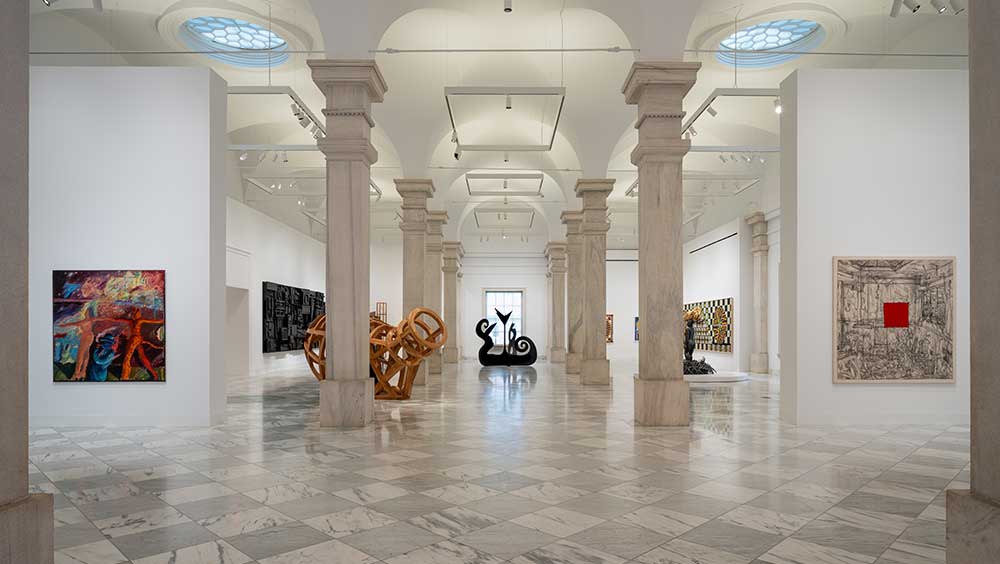
Installation view, American Voices and Visions: Modern and Contemporary Art, Smithsonian American Art Museum. Photo: Ron Blunt.
by LILLY WEI
After a more than two-year closure of its modern and contemporary galleries, on 22 September this year, the Smithsonian American Art Museum (SAAM) reopened its doors to the public in the imposing Old Patent Office Building (a National Historic Landmark which it shares with the National Portrait Gallery), revealing its new look. Redesigned by the architect Annabelle Selldorf, its reinstalled third-floor galleries glow, shorn of outmoded embellishments and polished a lustrous white. These galleries and the corridor between them are now lighter, brighter and more open, the flow from one space to another smoother, and in correspondence with the scale and aesthetics of the artwork represented. They lead to the great vaulted and colonnaded hall that is the Lincoln Gallery (where President Lincoln’s second inaugural ball took place), the installation space there substantively, if unobtrusively, increased, in part by the addition of some smaller galleries more suitable to smaller works.
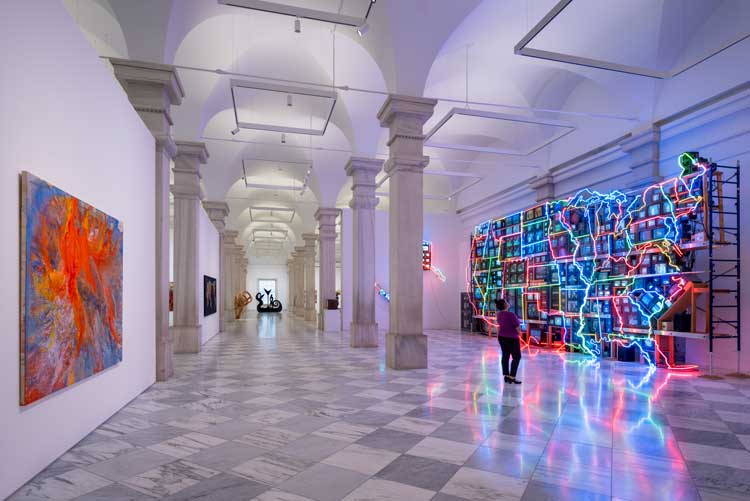
Right: Nam June Paik, Electronic Superhighway: Continental U.S., Alaska, Hawaii, 1995. Installation view, American Voices and Visions: Modern and Contemporary Art, Smithsonian American Art Museum. Photo: Ron Blunt.
It also revealed a new focus. Like other American museums recently, SAAM is determinedly diversifying, including in new media and technologies. The majority of the works on view in American Voices and Visions: Modern and Contemporary Art, the initial exhibition in the refreshed space are split between artists of colour (including Native American and Latinx artists, a group rarely featured in institutional and mainstream art exhibitions until recently), who weighed in at 52%, and female artists, at 42%, which is notably more than the usual breakdown, so kudos to the museum’s curators (who are mostly women, it should be noted) for moving the inclusion needle forward. In the show are also 42 recently acquired artworks by an equally diversified roster of artists, among them Firelei Báez, Tiffany Chung, Tseng Kwong Chi, Alison Saar and Kay Walkingstick (Cherokee Nation).
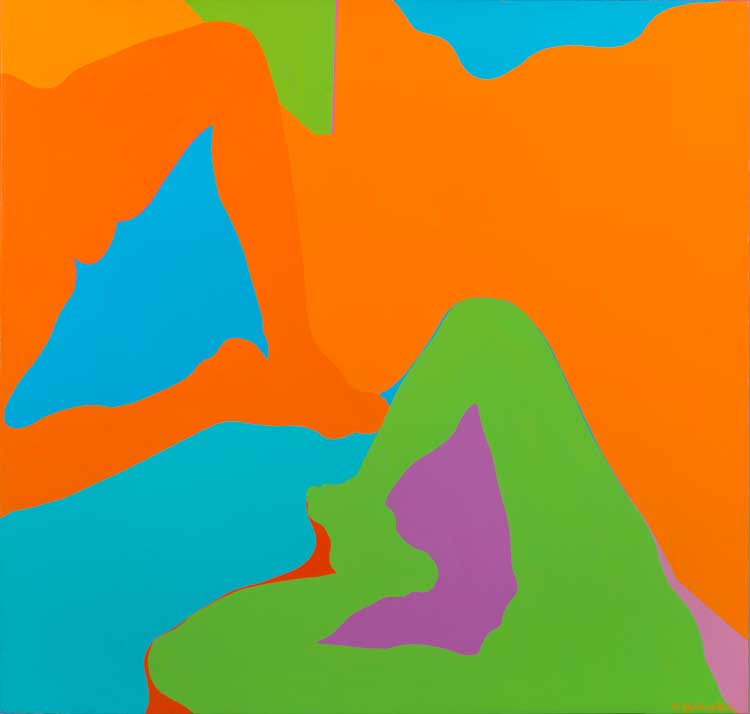
Kay WalkingStick, Two Women II, 1973. Acrylic on canvas, 42 3⁄8 × 44 1⁄8 in (107.6 × 112.1 cm). Smithsonian American Art Museum, Museum purchase through the Luisita L. and Franz H. Denghausen Endowment. © Kay Walkingstick, 2017.
The installation is not chronological, although there is a divide between the modern and contemporary. SAAM’s director, Stephanie Stebich, said that to present the reinstall as a linear series of artistic movements would be too “simplistic”, since it would not capture the “messy, dynamic, ever-evolving history” that is American art. Still, it seemed a bit like a tasting menu that left out quite a few expected entree selections as some major movements of 20th-century American art have gone missing, at least for now. Making the cut is abstract expressionism (Willem de Kooning, Clyfford Still, Joan Mitchell), the modestly sized room enlivened by the unexpected inclusion of a suspended, intricately twined wire sculpture by Claire Falkenstein, someone not often seen and who merits a re-evaluation.
.jpg)
Centre: Claire Falkenstein, Envelope, 1958. Steel wire assemblage, 48 x 60 x 36 in (122.0 x 152.4 x 91.4 cm). Installation view, American Voices and Visions: Modern and Contemporary Art, Smithsonian American Art Museum. Photo: Albert Ting.
There is another room dedicated to a handful of pioneering feminist artists: Miriam Schapiro’s cunning Dollhouse, a version of Womanhouse – with a studio of her own on the top floor – from 1972, and Audrey Flack’s flamboyant Queen (1976), a photorealist still life that is her version of a vanitas painting, one that symbolically proclaims the power of women, but more would have been welcomed. That said, the Washington Color School cohort is a winner, lit up by Alma Thomas’s ravishing red and white 1976 painting Red Azaleas Singing and Dancing Rock and Roll Music (for more of her uplifting work go to see Composing Color: Paintings by Alma Thomas elsewhere in the museum).
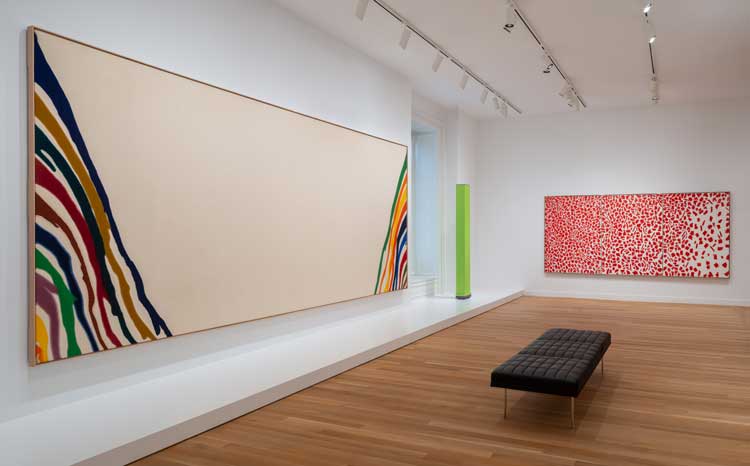
Left: Morris Louis, Beta Upsilon, 1960. Right: Alma Thomas, Red Azaleas Singing and Dancing Rock and Roll Music, 1976. Installation view, American Voices and Visions: Modern and Contemporary Art, Smithsonian American Art Museum.
Then there is Morris Louis’s sublime Beta Upsilon (1960), recently restored and shown for the first time in 30 years, and Sam Gilliam’s lyrically stained, unstretched canvas, a trio that alone would have been worth the price of admission – if there were an admission fee, another kudos for the Smithsonian museums in Washington.
.jpg)
Martin Puryear, Vessel, 1997-2002. Installation view, American Voices and Visions: Modern and Contemporary Art, Smithsonian American Art Museum. Photo: Albert Ting.
As you enter the vastness of the Lincoln Gallery, two of the museum’s most popular works, while very different from each other, are once more on display: Martin Puryear’s elegant, meticulously constructed Vessel (1997-2002), encumbered, haloed with the fraught narratives of slavery; and Nam June Paik’s go-for-broke Electronic Superhighway: Continental US, Alaska, Hawaii (1995), a gigantic 51-channel video installation in the form of a map of the US, each state outlined in neon and tagged by an unremitting barrage of sound collages. And there is a close-circuit camera in which visitors can see themselves in real time, always irresistible, located (of course) in Washington DC, the theme of political mapping reiterated in Chung and Báez’s works.
.jpg)
Jeffrey Gibson. Watchtower, 2018 (centre). Installation view, American Voices and Visions: Modern and Contemporary Art, Smithsonian American Art Museum. Photo: Albert Ting.
Nearby also are a trio of the signature supersized, trinket-and text-emblazoned tunics of Jeffrey Gibson (who is Mississippi Choctaw/Cherokee and will represent the US at the Venice Biennale in April). Based on the Ghost Shirts of the Sioux Lakota Tribe, the tunics hang regally, even defiantly, overhead from tipi poles. Encoded, their presence totemic, they were believed to have the power to deflect bullets. But they also function as a rebuke, majestic revenants reminding us of the unspeakable cruelty and humiliations inflicted on indigenous peoples in which ancestral spirits were no match for the flesh-and-bone shattering ferocity of firearms or the treaties that were worth less than the paper on which the US government wrote them.
.jpg)
Consuelo Jimenez Underwood, Run, Jane, Run!, 2004. Installation view, American Voices and Visions: Modern and Contemporary Art, Smithsonian American Art Museum. Photo: Albert Ting.
In the additional gallery spaces created in the Lincoln Gallery, the subjects are race, gender, personal and public personas, and other social and political issues, but there are few works that address the harsher aspects of American life head-on. Consuelo Jimenez Underwood’s Run, Jane, Run! (2004) is one exception. She refers to the unresolved quandaries of immigration and border crossings between the US and Mexico, her work based on the 1990 Immigrant Crossing sign that she reconfigures as a bright yellow tapestry, the colour of caution, interwoven with barbed wire, evoking the needless, pitiful deaths of so many.
American Voices, American Visions offers plentiful pleasures to look at and much to consider. Nonetheless, it feels curiously impersonal, as we proceed from work to work as if from monument to monument (we are in Washington, after all). That, however, is balanced by the temporary exhibitions where the “messy”, the “dynamic,” as well as the evolving and surprising could be more often found. Musical Thinking, New Video Art and Sonic Strategies features sound art and popular music, presenting works that are speculative and exuberant, and includes a dance video, flashing lights and a disco floor on which visitors can strut their stuff. Another engrossing exhibition is Many Wests: Artists Shape an American Idea. It re-examines the American west from disparate perspectives to invoke a much more granular, and authentic picture of what that mythic, romanticised construct was. SAAM’s new, state-of-the-art time-based media gallery was launched by the prodigious Carrie Mae Weems, an exhibition that includes the illusionistic conjuring of a red velvet-curtained 19th-century theatre called Lincoln, Lonnie, and Me – A Story in 5 Parts (2012) that imbricates past with present to unroll a wide-range of urgent, ongoing sociopolitical inequities.
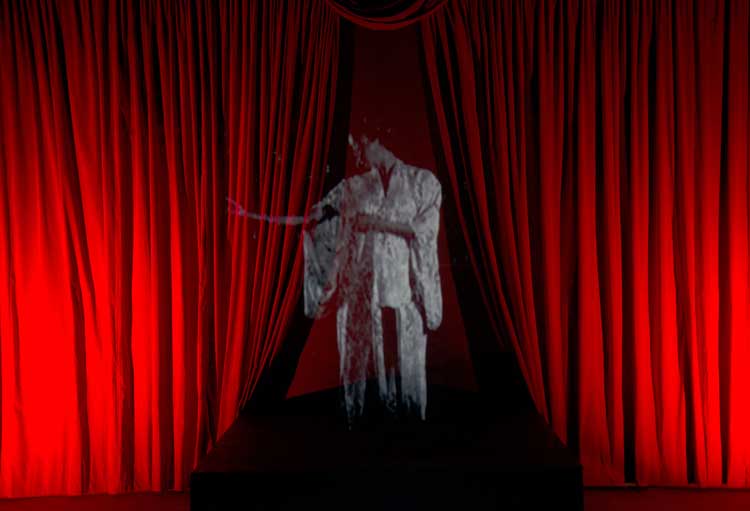
Carrie Mae Weems, Lincoln, Lonnie, and Me - A Story in 5 Parts, 2012. Video installation and mixed media, colour, sound, 18:29 minutes. Smithsonian American Art Museum, Museum purchase through the American Women’s History Initiative Acquisitions Pool, administered by the Smithsonian American
Women’s History Initiative. © Carrie Mae Weems. Courtesy of the artist and Jack Shainman Gallery, New York.
This is undoubtedly one of (if not) the most progressive ventures that the museum has yet sponsored, pledging, as it reinstalls, reinterprets and rotates its permanent collections in the future, to highlight art and artists excluded in the past. As the premier collection of American art in the nation, as SAAM claims to be, its mission, its chief curator, Randall Griffey, said, is “to tell the rich, deep story of art in America from the 18th century to the present”, an admirable ambition, one that I’m sure we will look forward to, a retelling, it is hoped, that will not be the same old story: so play it, SAAM.